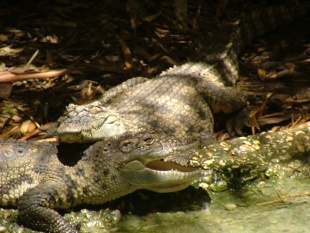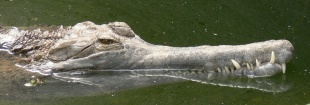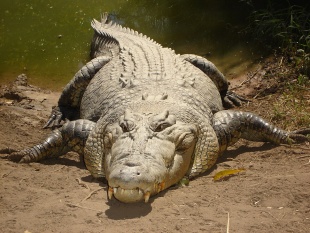SIAMESE CROCODILES
The Siamese crocodile is a small, freshwater crocodilian, with a relatively broad, smooth snout and an elevated, bony crest behind each eye. Overall, it is an olive-green color, with some variation to dark-green. The largest female specimens can measure 3.2 meters (10 feet) and weigh 150 kilograms (330 pounds) Large male specimens can reach 4 meters (13 feet) and 350 kilograms (770 pounds) in weight.
It is believed that only about 1,000 Siamese crocodiles remain in the wild, with more than 300 of them in Cambodia. Siamese crocodiles are listed as critically endangered by the International Union for the Conservation of Nature. They had all but disappeared by the 1990s due to poaching, habitat destruction and cross-breeding with other crocodile species. For a while they were thought to be extinct in the wild. In 2000, scientists found some in the Cardamom mountains in Cambodia. Since then about 100 have been found. Large crocodiles have been observed preying on animals as large as a water buffalo, but mainly they subsist on frogs, turtles, crabs and fish. About 11,000 Siamese crocodiles are being raised in crocodile farms.
The Siamese crocodile is native to Indonesia (Borneo and possibly Java), Brunei, East Malaysia, Laos, Cambodia, Burma, Thailand, and Vietnam. Its is now gone on the wild in most of its original range of these countries. When you here about crocodiles in these country in all probability they are saltwater crocodiles. Since 1992 a number of surveys have confirmed the presence of a tiny population in Thailand (possibly numbering as few as two individuals, discounting recent reintroductions), a small population in Vietnam (possibly less than 100 individuals), and more sizable populations in Burma, Laos and Cambodia. In March 2005, conservationists found a nest containing juvenile Siamese crocodiles in the southern Lao province of Savannakhet. There are no recent records from Malaysia or Brunei. A significant population of the crocodiles is known to be living in East Kalimantan, Indonesia. [Source: Wikipedia]
RELATED ARTICLES:
CROCODILES: CHARACTERISTICS, ANATOMY, DIFFERENCES WITH ALLIGATORS factsanddetails.com
PREHISTORIC CROCODILES: EVOLUTION, EARLIEST SPECIES, TRAITS factsanddetails.com
CROCODILE BEHAVIOR: COMMUNICATION, FEEDING, MATING factsanddetails.com
CROCODILES AND HUMANS: WORSHIP, THREATS, HANDBAGS factsanddetails.com
HOW TO CATCH A CROCODILE factsanddetails.com
CROCODILE ATTACKS IN ASIA factsanddetails.com
CROCODILES IN AUSTRALIA: HISTORY, SPECIES, BIG ONES, DWARVES, BATS, SHARKS ioa.factsanddetails.com
NEW GUINEA CROCODILES: TWO SPECIES, CHARACTERISTICS, BEHAVIOR AND REPRODUCTION ioa.factsanddetails.com
CROCODILE CULTURE AUSTRALIA: URBAN CROCS, ABORIGINALS, DUNDEE, STEVE IRWIN ioa.factsanddetails.com
CROCODILE ATTACKS IN AUSTRALIA: HOW, WHERE, WHY, DETAILS ioa.factsanddetails.com
CROCODILE ATTACKS IN NORTHERN TERRITORY AUSTRALIA ioa.factsanddetails.com
SURVIVING CROCODILE ATTACKS IN AUSTRALIA ioa.factsanddetails.com
Websites and Resources on Animals: Reptile Database reptile-database.org ; Reptileweb reptilesweb.com ; Reptile Phylogeny whozoo.org/herps/herpphylogeny ; Animal Diversity Web animaldiversity.org ; BBC Earth bbcearth.com; A-Z-Animals.com a-z-animals.com; Live Science Animals livescience.com; Animal Info animalinfo.org ; World Wildlife Fund (WWF) worldwildlife.org the world’s largest independent conservation body; National Geographic National Geographic ; Endangered Animals (IUCN Red List of Threatened Species) iucnredlist.org
Siamese Crocodiles in Cambodia
It’s believed that about 300 Siamese crocodiles remain in the wild in Cambodia. In 2017, wildlife researchers found six eggs in Sre Ambel District in the southern province of Koh Kong as they were exploring for tracks, signs and dung of the reptile. In 2021, eight hatchlings were found in in a river in the Srepok Wildlife Sanctuary in eastern Cambodia, Cambodia's Environment Ministry and the World Wildlife Fund said. Associated Press reported: “The team found the young reptiles after spending four days scouring habitat sites where months earlier they had discovered footprints and dung. “The government and WWF have jointly been searching for photographic evidence of a breeding population in the Srepok sanctuary without success for more than a decade, the wildlife organization said in a statement. The statement said the area is being guarded by Srepok Wildlife Sanctuary rangers. [Source: Associated Press September 21, 2021]
In May 2024, conservationists in Cambodia found 106 Siamese crocodile eggs in Cardamom National Park in western Cambodia — the biggest discovery in 20 years. Associated Press reported: Between June 27 and 30, a total of 60 eggs were successfully hatched, according to a joint statement issued by the ministries of agriculture and environment along with the conservation group Fauna & Flora. “This discovery indicates that the area is a key habitat for wild crocodiles, providing hope for the species recovery,” the statement said. [Source Associated Press, July 18, 2024]
The area and the young reptiles have been under the protection of Cardamom National Park Wildlife Sanctuary rangers, it added. Cambodian environment minister, Eang Sophalleth, said his ministry is working on the conservation and habitat restoration of these critically endangered Siamese crocodiles. The Siamese crocodiles play an important role in the ecosystem and the discovery of the five nets successfully hatching 60 eggs reflects that the Cardamom National Park is a safe and suitable habitat for this species,” Sophalleth said.
Philippine Crocodiles
Philippine crocodiles (Crocodylus mindorensis) are also known as Mindoro crocodiles and Philippine freshwater crocodiles. Names used in the Philippines include buwaya and bukarot (in northern Luzon). The only species endemic to the Philippines, Philippine crocodiles were discovered by Westerners on Mindoro island in the Philippines in 1935 by Karl Schmidt. Their discovery location is why they are sometimes called the Mindoro crocodile and have Mindoro in their scientific name. The Philippine crocodile has only been recognized as a separate species since 1989. Before that it was described as a subspecies of the New Guinea crocodile (Crocodylus novaeguineae). [Source: Jamison Law, Animal Diversity Web (ADW) /=]
Philippine crocodiles are considered to be the most severely threatened crocodile species in the world. By one estimate there are only 100 non-hatchling individuals left. There were roughly 250 left in the wild as of September 2011 according to an article by National Geographic. Recent surveys show it to be limited to northern Luzon and southwestern Mindanao islands. Philippine crocodiles were declared critically endangered in 2008 due to exploitation and unsustainable fishing methods, such as dynamite fishing. Since October 2021, they have classified as Critically Depleted by the On the International Union for Conservation of Nature (IUCN).
The Philippine crocodile is one of two species of crocodile that are found in the Philippines; the other is the larger saltwater crocodile. The Saltwater crocodile occurs from India to Australia to islands in the Pacific Ocean and is not globally threatened with extinction. In the Philippines however, saltwater crocodiles are now very rare and the species is locally extinct from many locations where it historically occurred. The Saltwater crocodile is normally found in coastal waters, mangroves, rivers and large lakes that are connected to the sea. They can reach lengths of six meters and are potentially very dangerous and feared as occasional man-eaters.
See Separate Article: PHILIPPINE CROCODILES: CHARACTERISTICS, BEHAVIOR AND REPRODUCTION factsanddetails.com
Mugger Crocodiles
Mugger crocodiles (Crocodylus palustris) are also called Indian, Indus, Persian, and marsh crocodiles. They are found throughout the Indian subcontinent and the surrounding countries. They are one of the three crocodilians found in India, with the others being the gharial and the saltwater crocodile. The scientific name “Crocodylus palustris” literally "crocodile of the marsh." The name "mugger" is a corruption of the Urdu word magar which means "water monster". This is in turn derived from makara, the Sanskrit word for crocodile. [Source: Wikipedia]
Mainly a freshwater species, the mugger crocodile is found in lakes, rivers and marshes. Muggers prefer slow-moving, shallower bodies of water rather than, fast-flowing, deep areas. They also thrive in man-made reservoirs and irrigation canals. They have some tolerance to saltwater therefore is occasionally reported from saltwater lagoons. Mugger crocodiles have adapted to terrestrial life like Cuban crocodiles but is ecologically most similar to African Nile crocodile. Muuger crocodiles are known for being mobile on land, can migrate considerable distances over land in search of a more suitable habitat. It can chase prey on land for short distances. They are also known to dig burrows as shelters during the dry seasons.
Mugger crocodiles are keystone species, meaning their presence or absence strongly affects populations of other species in area where they live. They are the top predators their ecosystem. The main threat of predation is during the hatchling stage. Crows and dholes have been reported as nest predators. There has been human predation of the eggs and fishermen occasionally kill adults. [Source: Gregory Steeves, Animal Diversity Web (ADW) /=]
The mugger crocodile can be found in India, Bangladesh, Sri Lanka, Pakistan, Nepal, the southern tip of Iran, and probably in Indo-China and at one point, even in Southern Iraq. The mugger is the only crocodilian found in Iran and Pakistan. This crocodile is the most common and widespread of the three species of crocodiles in India, far out numbering the much larger saltwater crocodile within the country (and most likely within neighboring countries).
See Separate Article: MUGGER CROCODILES: CHARACTERISTICS, BEHAVIOR AND REPRODUCTION factsanddetails.com
Chinese Alligators

Chinese alligator mother and young Chinese alligators are the smallest crocodilians. They average around two meters (six or seven feet) in length, about half their American counterparts. They are known in China as "tu long," or earth dragon, and may have inspired the dragon myth. The species, also known as the Yangtze alligator, is endemic to eastern China and has traditionally been found in the middle and lower reaches of the Yangtze River and were once found throughout the lakes and rivers in the lower Yangtze basin but now are only found in small areas in Zhejiang and Anhui Provinces about a hundred miles west of Shanghai. [Source: Carol Kaesuk Yoon, New York Times, August 21, 2001]
Chinese alligators live in a colder climate than other crocodilians and are the only crocodilians that hibernate. They usually hibernate in the winter in complex networks of burrows on the banks of their ponds. Chinese alligators are regarded as relatively mild mannered and non-threatening. They prefer living in lowland wetlands but because of development have so few places these days to live they have begun moving to forests and the slopes of hills, which are not suitable for burrowing. Adults can survive in these places buts eggs and young alligators often die if the weather gets too cold.
The Chinese alligator is the most endangered crocodilian in the world and may become the first crocodilian species to become extinct in the wild in historical times. In the old days there were hundreds of thousands of them, perhaps millions. Today only around 100 or 200 are left in the wild.
CHINESE ALLIGATORS: CHARACTERISTICS, BEHAVIOR AND REPRODUCTIONSee Separate Article: factsanddetails.com
Gharials
Gharials (Gavialis gangeticus) are one the rarest and most unusual-looking crocodilians and the most aquatic. Also known as gavials and fish-eating crocodiles, they are four to seven meters (13 to 23 feet) in length and spend most of their time in the water. Compared to other crocodiles, their legs are relatively weak and their feet are broadly webbed. This because these reptiles spend their time chasing after fish rather than lunging for prey at the shore like many crocodile species do. There are a few hundred and possibly a few thousand of them in India and Nepal. Before they used to also be found in Arabia, Bangladesh, Bhutan, Burma, and Pakistan.

male gharial
Gharials historically inhabited four river systems: the Indus (Pakistan), the Ganges (India and Nepal), the Mahanadi (India) and the Brahmaputra (Bangladesh, India, and Bhutan); it also may have occurred in the Irrawaddy River in Myanmar.[Source: Kyle Bouchard, Animal Diversity Web (ADW) /=]
Gharials in India prefer clear freshwater rivers with fast flowing currents. They congregate at river bends and other sections of rivers where the water is deep and the current is reduced. Because Indian gharials are not well adapted for moving around on land, they leave the water rarely, usually only to bask and to nest. They prefer sandbars in the middle of the rivers for both of these activities. Juveniles may seek out quiet backwaters or smaller streams.
Males have a strange stiff hollow knob on their snouts used in both visual and acoustic mating displays. The nostrils are closed with penislike erectile tissue that, when the animal is aroused, seals off the airways. During the breeding season dominant male gharial become strongly territorial and assemble a harem of females. Females create a nest far away from the water edge and lat 50 eggs which at 150 grams each are unusually large for crocodiles. The females protects her young but does not carry them to the water, perhaps because of the shape of their mouths.
See Separate Article: GHARIALS: CHARACTERISTICS, BEHAVIOR, REPRODUCTION, CONSERVATION factsanddetails.com
False Gharial
False gharial (Tomistoma schlegelii) are also known as Malayan gharials, false gavials and Sunda gavials. They are freshwater crocodiles native to the Malay Peninsula, Borneo and Sumatra with very thin and elongated snouts like gharials. Based morphology, they were originally placed within the family Crocodylidae (crocodiles), but recent immunological studies suggest that it is more closely related to gharials than was originally thought. False gharial are listed as an endangered species by IUCN with a population estimated to be below 2,500 mature individuals. [Source: Wikipedia]
There is still a debate over taxonomic classification of false gharials. They were listed in the family Crocodylidae based on fossil evidence and morphological similarities to extant crocodiles. Recently they have been placed in the family Gavialidae with ghavials based on biochemical, immunological and molecular characteristics. Gavialidae is made of only two orders each with one species: Genus Gavialis (with gharials as its one species) and Tomistoma (with false gharials as its one species). Genetic studies suggest that tomistomine and gavialine crocodilians should be placed into one taxon, which would comprise a sister group to the Crocodylidae. Other crocodilian researchers suggest considering Tomistominae and Gavialinae as sister taxa. [Source: Katie Foster, Animal Diversity Web (ADW) /=]
False gharials have an estimated lifespan in the wild of 60 to 80 years, similar to that of other crocodilians. Reports indicate that captive specimens have a shorter lifespan. Adult false gharials are not really threatened by any natural predator because of their large size but eggs and hatchlings preyed upon by wild pigs and and large reptiles, such as monitor lizards.
See Separate Article: FALSE GHARIALS: CHARACTERISTICS, BEHAVIOR AND REPRODUCTION factsanddetails.com
Saltwater Crocodiles
Saltwater crocodiles (Crocodylus porosus) are the world’s largest reptiles and predators that lives on land. They are larger than all mammalian land predators, including tigers, lions and bears and are arguably the most dangerous of all 28 species of crocodilian species. They can exceed six meters in length and can live up to 100 years. According to Mike Osborn, a real-life Crocodile Dundee and outback guide, they "can weigh as much as a four-wheel drive truck... Once they get past fourteen feet they suddenly broaden out, double in size...You wouldn't believe how massive they are. Once they've got you in their death roll. You're finished." [Source: David Doubilet, National Geographic, June 1996]
A large saltwater crocodile says National Geographic writer Rick Gore, "is cunning enough to stalk a human, strong enough to bring down and dismember a water buffalo, yet gentle enough to crack open its own eggs to release its young. Saltwater crocodiles have been seen on the east coast of India, Malaysia, Indonesia, Papua New Guinea, the Fiji Islands, the Philippines, and the island nation of Palau (600 miles east of the Philippines).
Saltwater crocodiles are also known as the esturine crocodile or Indo-Pacific saltwater crocodile. Saltwater crocodiles live for more than 70 years, according to the nonprofit conservation organization Oceana. Cassius described below is estimated to have lived to be over 120 years. It's difficult to determine a crocodile's age. Sometimes is estimated based on size. The rings on the femur bone can be counted similarly to rings on a tree but that can generally only be done after a crocodile dies. Saltwater crocodiles.have been a protected species in the Northern Territory of Australia since 1971. Between that time and 2005, their numbers grew from 3,000 to 70,000.
See Separate Article: SALTWATER CROCODILES: CHARACTERISTICS, BEHAVIOR, FEEDING AND REPRODUCTION factsanddetails.com
Image Sources: Wikimedia Commons
Text Sources: Animal Diversity Web animaldiversity.org ; National Geographic, Live Science, Natural History magazine, David Attenborough books, New York Times, Washington Post, Los Angeles Times, Smithsonian magazine, Discover magazine, The New Yorker, Time, Reuters, Associated Press, AFP, Lonely Planet Guides, CNN, BBC, Wikipedia, The Guardian, Top Secret Animal Attack Files website and various books and other publications.
Last updated February 2025





